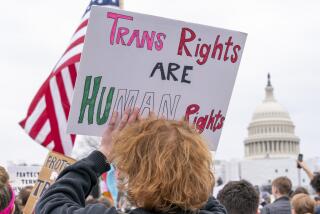First, decide DOMA
- Share via
What will the Supreme Court decide first: whether states can deny same-sex couples the right to marry or whether the federal government can refuse to recognize same-sex couples’ valid marriages under state law? Now that the U.S. 9th Circuit Court of Appeals has declined to rehear Perry vs. Brown, the challenge to California’s Proposition 8, and the 1st Circuit has ruled Section 3 of the federal Defense of Marriage Act, or DOMA, unconstitutional, that question has taken on an increased sense of urgency. Although Perry may provide more dramatic and compelling litigation, the DOMA cases present the Supreme Court with the best way forward.
First, the DOMA cases introduce fewer political complications, teeing up the relatively limited question of whether the federal government can deny recognition to existing marriages. The plaintiffs have challenged only Section 3 of DOMA, which prevents the federal government from recognizing same-sex spouses. Section 2, which largely restates existing principles regarding interstate recognition, is not at issue. If the court agrees with the 1st Circuit on Section 3, states with marriage equality would have their laws recognized by the federal government. States without marriage equality would be unaffected; such a ruling would neither require them to issue marriage licenses to same-sex couples nor compel them to recognize marriages from other states. The political backlash, therefore, would probably be relatively limited.
Perry, on the other hand, raises the prospect of a decision with nationwide implications. Plaintiffs’ attorneys Ted Olson and David Boies have analogized Perry to other landmark civil rights cases, most notably Loving vs. Virginia, in which the Supreme Court struck down interracial marriage bans. Consistently championing their clients’ fundamental right to marry, the Perry lawyers seek to bring marriage to same-sex couples nationwide. With only six states and the District of Columbia currently issuing marriage licenses to same-sex couples, they are asking the court to strike down laws in the majority of the states. The court is typically resistant to such sweeping action, and the political fallout from such a decision could be substantial.
Next, the DOMA cases present fewer doctrinal complications. Judge Stephen Reinhardt, writing for the 9th Circuit in February, narrowly decided Perry, ruling that California had no legitimate interest in eliminating same-sex couples’ right to marry and relegating them to a domestic partnership system. Indeed, in his concurring opinion in this week’s order denying rehearing, Reinhardt reiterated that the court’s February ruling was a limited one and had not resolved the more fundamental question of whether same-sex couples have a constitutional right to marry.
Reinhardt’s resolution tracked the arguments made not by Olson and Boies but by the city and county of San Francisco; lesbian, gay, bisexual and transgender rights organizations; and prominent law professors. Despite its strengths, Reinhardt’s lengthy opinion rests on more complicated reasoning than the 1st Circuit’s DOMA analysis in its May ruling. At the Supreme Court, Reinhardt’s logic will probably face some harsh critics, and in any event, the broader question of the fundamental right to marry may rise to the fore.
But in the DOMA cases, the high court may affirm the 1st Circuit decision under a relatively straightforward application of equal protection principles. The 1st Circuit issued a concise and unsentimental opinion, convincingly drawing on a line of Supreme Court decisions striking down laws in which “the protesting group was historically disadvantaged or unpopular, and the statutory justification seemed thin, unsupported or impermissible.” The court resisted the invitation to issue a broader ruling that would subject all sexual orientation-based classifications to more rigorous constitutional review.
Finally, the DOMA cases yield less weighty strategic concerns in the event the Supreme Court rules that Section 3 is constitutionally valid. LGBT rights advocates could continue to pursue state-based marriage reform, in the courts (as they are doing in Illinois, Nevada and New Jersey) and in the legislatures (as they have recently done in Maryland and Washington). And they could continue to pressure Congress to repeal DOMA.
In the case of Perry, however, if the court retains the Proposition 8 ban, LGBT rights advocates would be forced to return to the states. With constitutional amendments banning marriage for same-sex couples in a majority of states, advocates would be prevented from seeking reform in state courts and legislatures. Instead, they would in most states face the daunting proposition of trying to gain equal marriage rights at the ballot box. Some states might present reasonable opportunities — indeed, voters in Maine, Maryland and Washington may affirm same-sex couples’ right to marry in November — but others remain outside the realm of possibility for many years to come. And a series of ballot initiatives presents an overwhelming financial burden.
Perry provides a more exciting backdrop: a bitterly fought initiative battle, a heroic team of famous ideological rivals, a Hollywood-backed effort, a controversial appellate decision by the 9th Circuit’s liberal lion and gestures toward the big question of same-sex couples’ fundamental right to marry. But the DOMA cases present a more politically, doctrinally and strategically sensible way forward, and the high court would be wise to start with them. There are other cases like Perry in the pipeline, and the court will no doubt have many opportunities to weigh in on the question of marriage equality.
Douglas NeJaime is an associate professor at Loyola Law School in Los Angeles.
More to Read
A cure for the common opinion
Get thought-provoking perspectives with our weekly newsletter.
You may occasionally receive promotional content from the Los Angeles Times.






